by Carrie Jennings, Freshwater Society
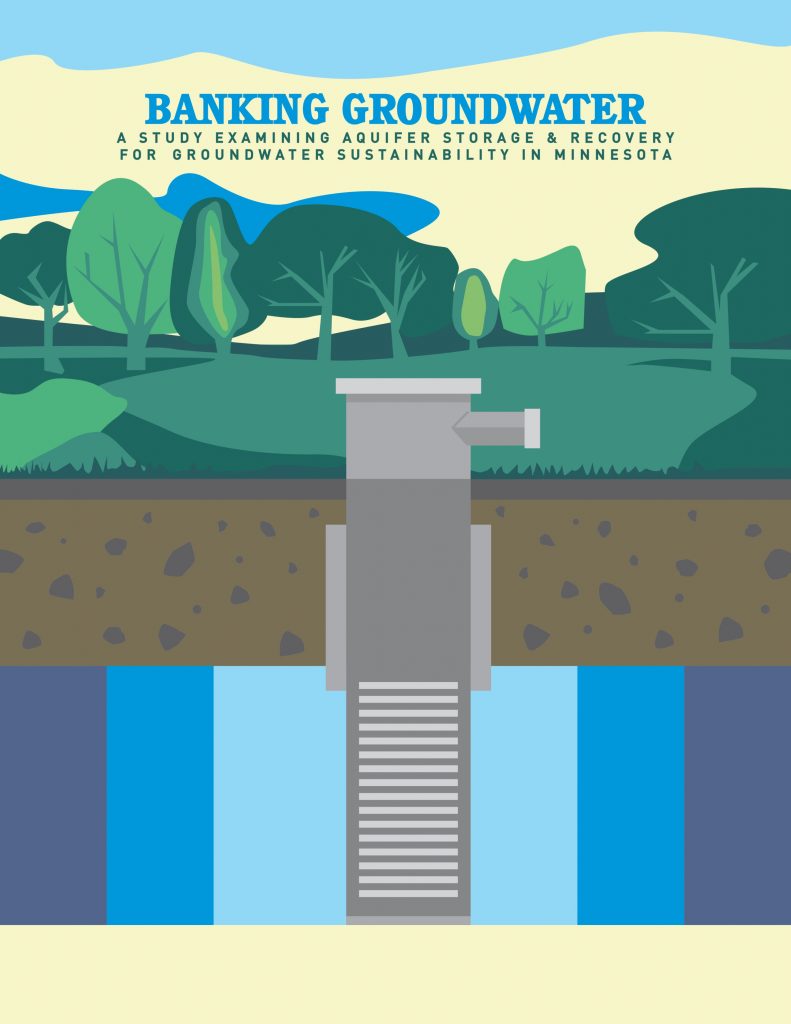
An interdisciplinary study, Banking Groundwater: A study examining aquifer storage and recovery for groundwater sustainability in Minnesota, funded by the LCCMR in 2018 was recently completed after an 18-month study. Freshwater and the Water Resources Center convened key partners in the School of Earth Sciences, Civil, Electrical, Geological and Environmental Engineering and the Humphrey School of Public Policy to examine the feasibility, both physical and economic, of deploying ASR and identified policy barriers that currently would limit the practice of recharging aquifers.
Introduction and Motivation
Managed aquifer recharge encompasses a number of techniques for maintaining aquifer levels. Aquifer Storage and Recovery (ASR) is one of those technological approaches that involves treating and pumping clean water into an aquifer for temporary storage and later recovery. ASR wells may inject water into either a confined or unconfined aquifer.
Motivations to deploy ASR include:
- creating reliable seasonal water supply;
- meeting peak demand without building a larger treatment plant;
- creating water reserves that are less vulnerable to contamination;
- conserving land area used for water storage; and
- sustaining groundwater-fed ecosystems like trout streams, lakes, and fens.
Study Areas
We examined four different kinds of aquifers across Minnesota, each with unique pressures. The hydrogeological characteristics of the aquifers that control how water moves are used to determine the volume and rate of water that can be injected. The chemistry of the source water and aquifer water impact the required treatment needs prior to injection and after extraction. This in turn impacts the economic feasibility of a project.
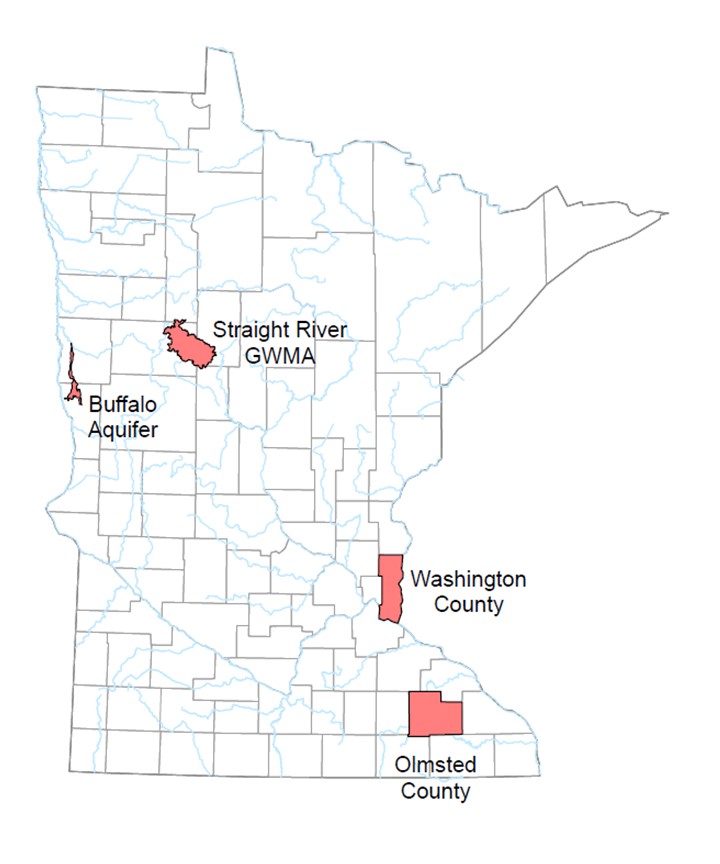
Findings
The study findings suggest that three of the four study areas may be suitable for ASR. The Buffalo aquifer in Moorhead has variable injection capacity and multiple sources of water for injection. Water quality issues of arsenic, sulfate, manganese, and hardness would require treatment after extraction. The Jordan aquifer in Rochester faces increased pressure from growth and nitrate contamination in the surrounding agricultural areas. The wastewater treatment plant could provide adequate source water if treated. Woodbury faces pressure from increasing population and PFAS contamination of the Jordan aquifer. ASR could recharge groundwater from wastewater treatment plants and also be integrated with PFAS remediation scenarios by reinjection of treated groundwater. ASR is not recommended for the surficial sand aquifer in the Straight River Groundwater Management area in north central Minnesota because there is no source of water to make it a feasible option at this time.
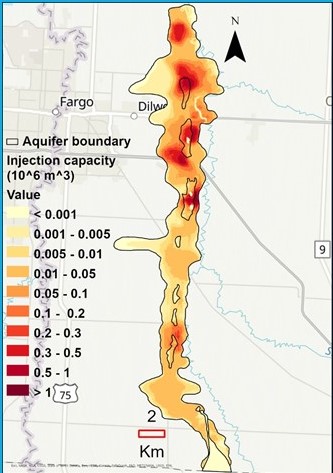
Example of injection capacity maps produced for the study aquifers. Injection capacity is a critical characteristic to determine the suitability for ASR.
Calculating Injection Capacity
Injection capacity is primarily limited by how thick and how transmissive the rock or sediment layer is. Limiting conditions for ASR projects are that they do not flood the surface in an unconfined-aquifer setting or fracture the confining unit in a confined-aquifer setting. The tool produced maps for three of the four study aquifers that show: (1) the long-term, average groundwater level and depth-to-groundwater; (2) aquifer-characteristic data obtained from aquifer tests and specific capacity tests; (3) available headspace in the aquifer where water can be safely injected for storage, and (4) injection capacity of the aquifers.
Economics
Economic considerations would most likely be the final determinant for whether a municipality adopts ASR to provide water to its residents. Cost-benefit analysis combined with a sensitivity analysis of economic factors is therefore a necessary component of any feasibility study. It is likely that there are less expensive options including switching to surface water, conservation, and water reuse. However, where these have been exhausted, it may be necessary for a city to consider ASR.
Policy and Permitting Considerations
Modifying state well code and streamlining a permitting path would allow for more successful development and deployment of ASR by cities facing an urgent need for sustainable groundwater. State adoption of control over Class V injection wells from the US Environmental Protection Agency will also streamline the process. Currently, the lack of a clear permitting path and the variances that would be required for ASR to be allowable under the Minnesota Well Code place extra burden on individual water suppliers (and MDH). Removing these administrative and political barriers is not an incentive to pursue ASR, rather, the purpose of streamlining permitting and assuming primacy over Class V injection wells, would be to remove these burdens on cities as they consider ASR projects where it has been scientifically and economically determined to be the best option. The Report also recommends that an ASR decision support system be developed for Minnesota to assist cities considering ASR as a water-management option. One example is offered here.
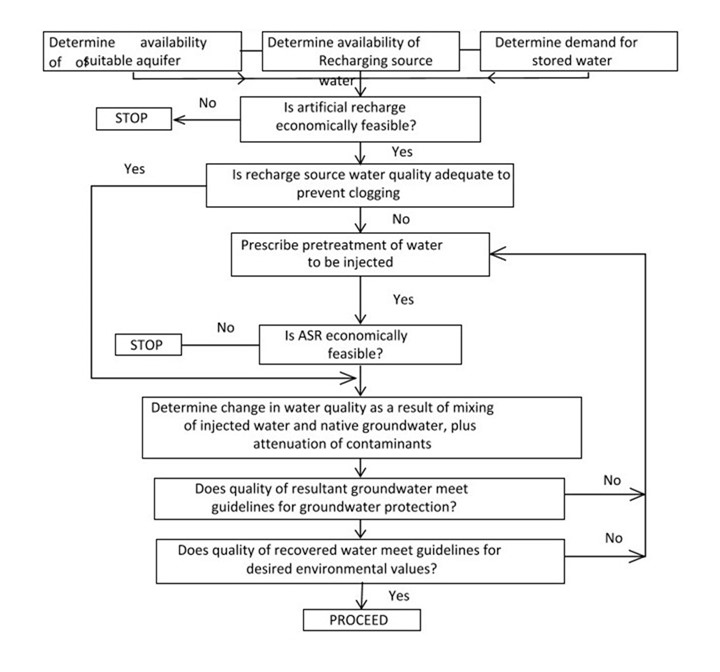
Case Studies
The report also included seven case studies that represent a cross-section of the kinds of systems being adopted by a range of U.S. municipalities. They showcase different environmental conditions, water sources and technology and include examples of ASR and ASR-type systems. Reflection on these and the lessons learned can provide valuable insight for future application of ASR in Minnesota. The seven case studies included in the full report are:
- Shakopee-Mdewakanton Sioux Community, Minnesota
- St. Michael, Minnesota
- Des Moines and Ankeny, Iowa
- Green Bay, Wisconsin
- El Paso, Texas
- Tucson, Arizona
- Roseville, California
Data Gaps and Limitations
Our modelers were limited by available data. Low spatial density of groundwater levels and the absence of time-series data limited the understanding of allowable head change both seasonally and inter-annually. Pump test data of longer duration assess properties farther away from a well and are more desirable. The more common, specific-capacity tests measure properties closer to the well are adequate but not ideal.
A complete aquifer properties database with a good public interface would have simplified this modeling effort. Such a database would include the details of how an aquifer is tested as well as the results of the test because both important to assessing the suitability of a site for ASR. A complete, unified aquifer-property database would ultimately save the state money by making all historic data available, thereby avoiding the need to repeat pump tests. It would also make ASR project design and other groundwater modeling efforts less expensive. A database structure has been created and MnDNR is populating it, focusing on areas of interest to them. However, information created and housed by other agencies, consulting companies, archived in technical documents and in published articles is slow to be interpreted and entered. This is complicated by pump tests and aquifer property data not being reported in a standardized way. The database is not user-friendly so data are not easily retrieved. A complete and useful database will require continued collaboration and additional resources.
The modeling conducted for this study made simplifying assumptions using available hydrogeologic data. The next steps for future studies could address factors that affect the recovery of injected water from an ideal, uniform scenario pictured here including: leakage, density differences of the two waters, dispersive mixing, hydraulic gradient that could migrate the water, storage duration, and fractures in the aquifer or confining unit.
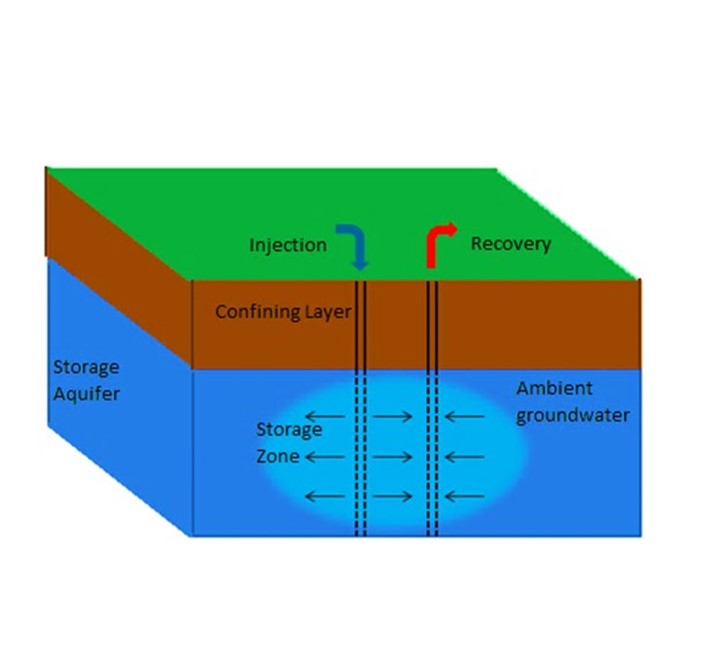
Recommendations
If we can all agree that water is a public good, then it is the responsibility of the government to make it accessible to all. Where groundwater levels are depleted and not naturally recovering with sufficient speed, we recommend that artificial recharge options be considered and implemented where feasible and appropriate. ASR is a tool that may be useful in ensuring groundwater sustainability in some places with strict oversight, clear guidelines and a permitting path. However, ASR should remain a tool of last resort after other approaches to meet groundwater sustainability needs are exhausted. To this end, the State should first encourage conservation efforts and second, eliminate barriers to water reuse. The suggested actions are tentatively assigned to the implementers with a potential timeline.
| Action | Implementers | Timeline |
| Develop and support legislation to advance ASR as a tool for sustainable groundwater use | Legislature | Now |
| Develop an ASR-decision-support system for interested communities | Interagency groundwater team; study authors; interested communities | Near term |
| Apply to EPA for primacy over Class V injection wells | MDH, as directed by the legislature | Near term |
| Modify State well code to allow injection wells | MDH lead with interagency groundwater team and stakeholders | Mid term |
| Review progress and evaluate need to modify centralized aquifer-property database | DNR with other agencies and MGS | Now |
| Acquire aquifer properties and apply GIS-tool to other aquifers where ASR is being considered. | Kang Group at the U of M, Earth and Environmental Sciences with MGS and DNR | as requested by municipalities |
| Make a cost-benefit analysis tool available for ASR projects following FEMAs 2016 Methodology for Aquifer Storage and Recovery Benefit Cost Analysis. | MDH lead with Water Resources Center | Mid-term |
| Develop permit process with engineering and environmental requirements that must be met that may include: 1) source water considerations including pre-treatment; 2) avoidance of potential aquifer impacts; 3) post-treatment requirements; 4) pilot project requirements, and 5) on-going reporting and monitoring. | MDH lead | Mid-term |
The final technical report is a comprehensive, whopping 251 pages with figures and graphics. Whether you are looking for the full report, a shorter, plain language Executive Summary or individual chapters, visit the project website hosted by the Water Resources Center. MGWA members might be most interested in the chapter that describes the aquifer properties required to deploy a new, GIS-based tool to map the recharge capacity of aquifers (Section 2).
There is already forward momentum on some of the recommendations. Rep. Sandell (Woodbury) who carried the original bill is proposing Legislative language to support the next steps.
Acknowledgements
Funding for this project was provided by the Minnesota Environment and Natural Resources Trust Fund as recommended by the Legislative-Citizen Commission on Minnesota Resources (LCCMR). The Trust Fund is a permanent fund constitutionally established by the citizens of Minnesota to assist in the protection, conservation, preservation, and enhancement of the state’s air, water, land, fish, wildlife, and other natural resources. Currently 40% of net Minnesota State Lottery proceeds are dedicated to growing the Trust Fund and ensuring future benefits for Minnesota’s environment and natural resources. The methodology developed in this study is also partly supported by a grant from the Future Research Program (2E27030) funded by the Korea Institute of Science and Technology (KIST). Etienne Bresciani acknowledges support from the Korea Research Fellowship program funded by the Ministry of Science and ICT through the National Research Foundation of Korea (grant 2016H1D3A1908042).

Full report information
A full report is available that accompanies and supports this executive summary. The full report includes:
- Introduction to groundwater use in Minnesota
- Introduction to ASR
- Hydrogeological characterization of aquifers and injection capacity
- Engineering and environmental requirements
- Policy considerations
- Economics
- Case studies
The full report is available online at www.wrc.umn.edu/banking-groundwater-managed-aquifer-recharge or in alternative formats by request.
We examined four different kinds of aquifers across Minnesota, each with unique pressures.
Authors
| Carrie Jennings Freshwater John Bilotta UMN Water Resources Center William Arnold UMN Civil, Environmental, and Geo-Engineering Peter Kang UMN Earth and Environmental Sciences Seonkyoo Yoon UMN Earth and Environmental Sciences Raghwendra N. Shandilya Korea Institute of Science and Technology Etienne Bresciani Korea Institute of Science and Technology Seunghak Lee Korea Institute of Science and Technology | Joshua Kirk UMN Civil, Environmental, and Geo-Engineering Lucia Levers UMN Water Resources Center Brian Bohman Freshwater and UMN Water Resources Science graduate student Eileen Kirby UMN Water Resources Center and Freshwater Society Anthony Runkel Minnesota Geological Survey, UMN Earth and Environmental Sciences Galen Xiang Freshwater Phillip Gassman Center for Rural Development, Iowa State Adriana Valcu-Lisman Center for Rural Development, Iowa State |
MGWA is committed to developing a just, equitable, and inclusive groundwater community. Click on the button below to read MGWA’s full diversity statement.